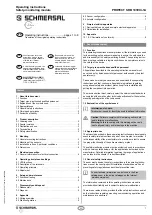
3
PROTECT SRB 101EXi-1A
Operating instructions
Safety-monitoring module
EN
Fuse rating of the
safety contacts:
3.15 A slow blow
Recommended fuse for
the auxiliary contacts:
2 A slow blow
Utilisation category
to EN 60947-5-1:
AC-15 / DC-13: EN 60947-5-1
Dimensions (H/W/D):
100 mm x 22.5 mm x 121 mm
The data specified in this manual is applicable when the component
is operated with rated operating voltage U
e
± 0%.
EX-relevant Data
EG-prototype test/
prototype test:
TÜV 08 ATEX 7522
TÜV 08 ATEX 7557 X
Group, Category,
Ignition protection type:
Gas:
L
II 3 G Ex nAnC IIC T5
(SRB in zone 2)
Gas/dust:
L
II (2) GD [Ex ib] IIC /
[Ex ibD] (circuits in zone 1, 21/2, 22)
Maximum safety voltage U
m
:
253 VAC
(
caution:
U
m
is not a rated voltage!)
Inputs:
S11-S12, S21-S22, X1-X3:
[Ex ib] IIC / [Ex ibD]
Temperature class:
T5
Voltage U
o
:
33.6 V
Current I
o
:
57.0 mA
Power P
o
:
478.8 mW (linear characteristic)
Separation
(intrinsically safe/other circuits):
safe separation to EN 60079-11,
amplitude of the voltage 375 V
Gas group
II C
II B
external capacity
C
o
(nF)
26 36 46 49 160 180 230 280 350 412
external inductivity
L
o
(mH)
4.0 2.0 1.0 0.5 38.0 5.0 2.0 1.0 0.5 0.2
Reference values for cable:
C ≈ 200 nF/km, L ≈ 1 mH/km (C ≈ 200 pF/m, L ≈ 1 µH/m)
2.5 Safety classification
Standards:
EN ISO 13849-1, IEC 61508,
EN 60947-5-1
PL:
Stop 0: up to e
Control category:
Stop 0: up to 4
DC
99% (high)
CCF:
> 65 points
SIL:
up to 3
Service life:
15 years
B
10d
value (for one channel):
Low voltages range 20%: 20,000,000
40%: 7,500,000
60%: 2,500,000
80%: 1,000,000
Maximum load 100%: 400,000
MTTF
B
d x
x
h
s/h
3600
d
10d
op
op
op
n
0,1 x n
op
t
cycle
For an average annual demand rate of n
op
= 126,720 cycles per
year, Performance Level PL e can be obtained at maximum load.
n
op
= average number of activations per year
d
op
= average number of operating days per year
h
op
= average number of operating hours per day
t
cycle
= average demand rate of the safety function in s
(e.g. 4 × per hour = 1 × per 15 min. = 900 s)
(Specifications can vary depending on the application-specific
parameters h
op
, d
op
and t
cycle
as well as the load.)
3 Mounting
3.1 General mounting instructions
Mounting: snaps onto standard DIN rails to EN 60715.
Snap the bottom of the enclosure slightly tilted forwards in the DIN
rail and push up until it latches in position.
3.2 Mounting of the sensors
The installation of the intrinsically safe current circuits must be executed
in accordance with the applicable standards EN 60079-14 or EN 61241-14.
According to EN 60079-11, the following must be observed
for the installation: a distance of ≥ 6 mm must be observed
between the terminals of the intrinsically safe current circuits
and other intrinsically safe current circuits. Between the
terminals of the intrinsically safe current circuits and other,
non-intrinsically safe current circuits, a distance of ≥ 50 mm
must be observed.
The commissioning and installation are to be executed by
qualified professionals only.
3.3 Installation in Zone 2: particular conditions
• The devices must be installed in control or junction boxes, which meet
the requirements to EN 60079-15 and have at least protection class
IP 54 (Fig. 1). To respect temperature class T5, the device must have
a free volume of at least 2,400 cm
3
.
• Please make sure that you have read and understood these operating
instructions and that you know all applicable legislations regarding
occupational safety and accident prevention prior to installation and
putting the component into operation.
• The intrinsically safe current circuits of the device (light blue terminals)
may be lead in explosion-endangered areas. In this case, it must be
especially observed that they are safely separated from all non-intrin-
sically safe current circuits.
• The connection and separation of the connections of
non-intrinsically safe current circuits is not authorised
in explosion-endangered atmospheres.
• Only use a damp cloth to clean the enclosure.
• The lifetime of the safety-monitoring related to the ignition
protection class "nC" is at least 15 years.
Upon expiration
of this time, the safety-monitoring module must be repla-
ced either returned to the manufacturer for check-up!
The temperature specifications (–25°C ≤ Ta ≤ +60°C) of
the safety-monitoring module are related to a volume of the
control cabinet of at least approx. 2,400 cm
3
for each SRB.
The distance with regard to other safety-monitoring module
imperatively must be at least approx. 5 cm.








